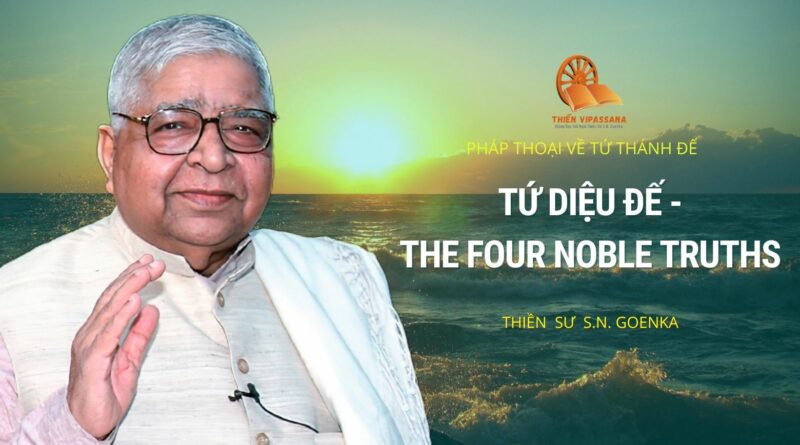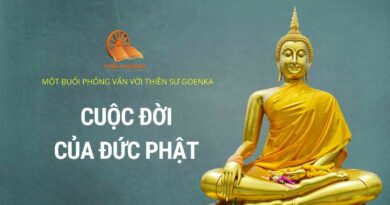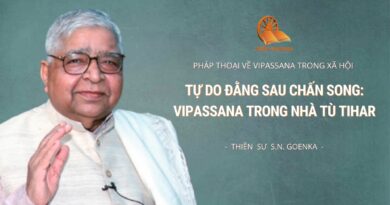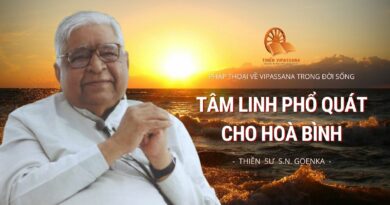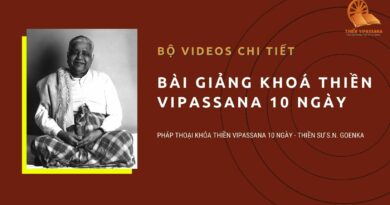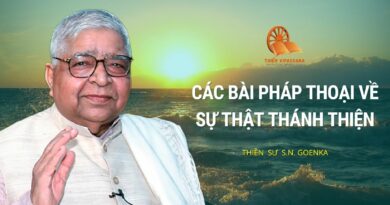The Four Noble Truths – Tứ Diệu Đế
The Buddha taught the Four Noble Truths, which includes the theoretical as well as the practical aspect of his teaching.
Đức Phật đã dạy Tứ Diệu Đế, bao gồm cả khía cạnh lý thuyết và thực tiễn như sau.
The Noble Truth of Suffering: the entire field of suffering has to be known by experience.
Chân lý về sự khổ đau : toàn bộ những điều đau khổ nên được biết đến bằng kinh nghiệm.
The Noble Truth of the Arising of Suffering: the eradication of craving has to be experienced.
Chân lý về sự phát sinh khổ đau: sự diệt trừ tham ái phải được trải nghiệm.
The Noble Truth of Cessation of Suffering: the realization of Nibbāna.
Chân lý chấm dứt khổ đau: sự chứng ngộ Nibbāna
The Noble Truth of the Path leading to the Cessation of Suffering: this has to be developed by repeated practice.
Chân lý về Con đường dẫn đến trạng thái Giải Thoát Khổ: điều này cần được phát triển bằng việc thực hành một cách liên tục
Hearing these truths and understanding them at the intellectual level is good but not sufficient. To benefit from these truths, it is essential to gain knowledge about them through experiential wisdom. Merely learning about them from others and understanding them at the intellectual level cannot make one sthitaprajña or an arahant.
Nghe và hiểu những chân lý trên ở cấp độ hiểu biết là tốt nhưng chưa đủ. Để đạt được lợi lạc từ những chân lý này, điều cần thiết là phải đạt được hiểu biết thực tiễn. Chỉ học những chân lý này từ người khác và hiểu chúng ở cấp độ hiểu biết không thể làm một người trở thành sthitaprajña hay một vị thần .
The Buddha taught his five companions how to develop in wisdom and get established in it. All five became established in wisdom and became arahants. In the following quotation from a tradition in our country, we find reference to such arahants:
Tasya prajñā pratiśthitā (Bhagavadgītā 2.57-58)
Yathindakhīlo pathavim sito siyā, catubbhi vātehi asampakampiyo tathūpamaṃ sappurisaṃ vadāmi, yo ariyasaccāni avecca passati. -Dhamma-vandanā, Ratana-sutta-8
Đức Phật đã dạy năm người bạn đồng hành của Ngài cách để phát triển trí tuệ. Cả năm người đều đạt được trí tuệ và trở thành những vị thần. Trong những trích dẫn sau đây từ một truyền thuyết ở nước ta, chúng tôi tìm thấy những tài liệu tham khảo về những vị thần như sau:
Tasya prajñā pratiśthitā (Bhagavadgītā 2.57-58)
Yathindakhīlo pathavim sito siyā, catubbhi vātehi asampakampiyo tathūpamaṃ sappurisaṃ vadāmi, yo ariyasaccāni avecca passati. -Dhamma-vandanā, Ratana-sutta-8-“Just as Indra’s pillar (a strong post at the entrance of a city), that is firmly embedded in the earth remains unshaken by the winds blowing from the four directions, similarly I declare as truly virtuous that person who has fully comprehended the four Noble Truths by direct experience. Such an arahant who is established in wisdom remains unshaken under all circumstances.”
-“Cũng như trụ cột Indra (một cái trụ mạnh mẽ ở lối vào của một thành phố), được đóng chặt vào trái đất và không bị lay chuyển bởi gió thổi từ bốn hướng, điều này cũng đạt được tương tự với một người thấm nhuần Tứ Diệu Đế bằng kinh nghiệm trực tiếp. Giống như một vị thần có được trí tuệ không hề bị lay chuyển trong mọi hoàn cảnh.”
Misconceptions – Quan niệm sai lầm
When the original scriptures containing the Buddha’s teaching and the practice of Vipassana were totally lost from our country, some opponents of the Buddha and some ignorant people spread false comments about the four Noble Truths.
Khi những lời dạy ban đầu của Đức Phật và việc thực hành thiền Vipassana hoàn toàn bị đánh mất ở đất nước chúng tôi, một số người phản đối Đức Phật và những người thiếu sự am hiểu đã làm lan truyền một số quan niệm sai lầm về Tứ Diệu Đế.
One misconception that they spread was that the teaching was utterly pessimistic and useless; and therefore it was lost from our country—because the word suffering was used four times whereas happiness was not mentioned at all.
Một quan niệm sai lầm rằng : việc giảng dạy Tứ Diệu Đế là bi quan và vô dụng; và do đó nó bị đánh mất ở đất nước chúng ta – bởi vì từ ngữ đau khổ được sử dụng đến bốn lần trong khi từ hạnh phúc hoàn toàn không được nhắc đến.
Unless one practices Vipassana, how can one understand that the cessation of suffering (dukkhanirodha) is nothing but supreme happiness? Similarly, the practice of the other three truths also leads to supreme happiness.
Trừ khi một người thực hành thiền Vipassana, làm sao họ có thể hiểu được sự diệt trừ khổ đau (dukkhanirodha) không gì khác ngoài hạnh phúc tối cao?
Another misconception which they spread was, ‘How can suffering be called noble?’
Một quan niệm sai lầm khác đã được lan truyền là , “Làm sao đau khổ lại được gọi là chân lý?”
When one practices Vipassana, one understands that when any one of the four Noble Truths is thoroughly experienced, it makes one a noble person.
Khi một người thực hành Vipassana, họ hiểu được rằng khi một trong bốn điểm của Tứ Diệu Đế được trải nghiệm, nó sẽ giúp người đó trở nên cao quý.
Keep this in mind and work. Distribute this wonderful Dhamma for your good and for the good of so many suffering people around the world. May pure Dhamma spread! May more and more people start practicing Dhamma to enjoy real peace, harmony, happiness!
Ghi nhớ những điều này và thực hành. Lan tỏa Dhamma tốt đẹp này vì lợi ích của bạn và của nhiều người đau khổ khác trên thế giới. Nguyện cho Dhamma thanh tịnh được lan rộng! Nguyện cho ngày càng nhiều người bắt đầu thực hành Dhamma để được hưởng sự bình an, hòa hợp, hạnh phúc thật sự.
Nguồn Viện Nghiên Cứu Vipassana VRIDhamma.org

